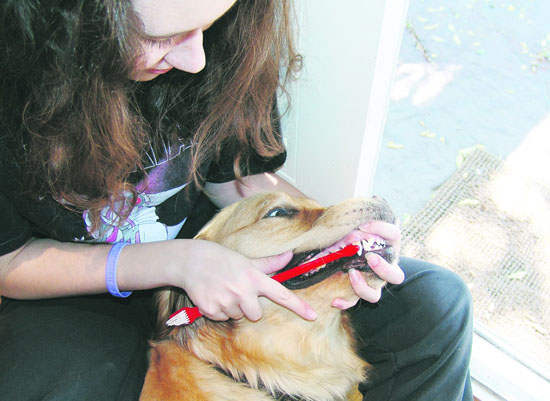| | Published September 17, 2008
| DENTAL CARE
| | By Mona Miller, DVM |  | | Amanda Griggs brushes the teeth of her dog, Amberite |
Dogs and cats develop dental disease, much like humans.... but think about it - we brush and floss as often as every 12 hours to maintain the health of our mouth. How many of our pets can say the same? Bacterial accumulations called plaque form on the surface of a tooth and if not brushed away, will quickly start to mineralize and harden into tartar (or calculus). This is the yellow-brown deposit on the tooth's surface that is readily visible. Gingivitis is inflammation of the gums, which can be seen as reddening and swelling. Progression of gingivitis leads to periodontitis, which is inflammation of the tissues surrounding the tooth itself. Signs such as bad breath, calculus build-up, inflamed gums and loose teeth all indicate levels of dental disease that should be addressed. The bacterial load in the mouth can be so high and imbalanced with "bad" bacteria that infection can develop internally, in heart valves, kidneys and liver.
Some animals are more susceptible to developing gingivitis and periodontal disease: small breed dogs are at higher risk (probably because of their small mouths having to make room for the same 42 teeth as a long-nosed dog), diabetic patients, and cats with certain viruses.
Because every animal is different, there is no set recommendation for how often a full dental cleaning should be performed. Your veterinarian will assess your pet's mouth at each annual (or semi-annual) physical examination. A thorough dental cleaning involves full anesthesia. This allows for two things: to clean below the gum line with an ultrasonic scaler, and to intubate the trachea for prevention of bacterial spread into the respiratory system. Risks of anesthesia are minimized with a pre-anesthetic physical examination and blood tests to assess liver and kidney status. During the dental procedure, vets often use intravenous fluids, antibiotics, anti-inflammatory drugs and pain medications. The specifics of these can be discussed with your veterinarian, in context of your dog or cat's general health, age and your preferences.
Home dental care is the best preventive for frequent anesthetic dentistry, as well as for maintaining the health of your dog's mouth to prevent periodontal disease and infections. Pet toothbrushes and specially flavored pet toothpastes are widely available (dogs and cats seem to prefer malt or poultry, not mint!). Daily brushing is ideal, but even if you brush your dog's mouth three times weekly, there is 40% less plaque build-up. Special dental diets, such as Hill's t/d, provide a mechanical scrubbing effect on the tooth surface to reduce plaque. The Veterinary Oral Health Council (VHOC) has awarded a seal of approval on several types of chew treats that are also suitable.
|
 | | Dr. Mona S. Miller lives in Lafayette with her 3 year old son and her yellow Labrador Retriever. She has worked at Four Seasons Animal Hospital in Lafayette since moving here in 2001. She attended Cal as an undergrad, and received her DVM from U.C. Davis. She can be reached at Four Seasons, 938-7700, or by email to MonaSDVM@aol.com. |
Fall in the Wildlife Hospital
The Lindsay Museumé─˘s wildlife hospital has received more than 4,400 injured or orphaned wild animals since the beginning of the year. With a little bit of knowledge and a few changes in habits, we can greatly reduce our impact on the regioné─˘s wildlife.
Keep pet food indoors: Wild animals can become dependent upon humans or our petsé─˘ food and may carry diseases that can make humans and pets sick.
Doné─˘t feed the ducks: Bread and crackers are not natural duck foods and can make them very sick. Feeding ducks can also lead to overpopulation that spreads disease and causes death.
Tree pruning: To avoid disturbing bird and squirrel nests, the best time to prune your trees is from October through December.
Doné─˘t use pesticides or insecticides or rodenticides: These poisons may also kill wildlife and pets and can harm the environment.
Screen your chimneys, attic and basement vents: Many birds and mammals like to nest in dark, quiet places. Screening will prevent accidental injuries and keep animals out of your home.
Doné─˘t use sticky traps: Insect and rodent traps made with sticky substances can harm and kill many other animals including birds and reptiles. Use snap traps for rodent controlé─ţ they are more humane.
Bird netting: Avoid the use of plastic bird netting, especially near the ground. It can trap and entangle many wild animals. Use a stiffer wire mesh instead.
Lawns: Treat your lawn with beneficial nematodes in the spring so that raccoons woné─˘t dig looking for grubs in the fall.
Call 925-935-1978 or visit www.wildlife-museum.org for more information including museum hours and admission prices.
Lindsay Wildlife Museum connects people with wildlife to inspire responsibility and respect for the world we share. The museum houses a collection of live, native California animals, a hands-on discovery room for children, a pet education section with domestic animals, changing exhibits and a wildlife rehabilitation hospital that treats about 6,000 animals every year.
| | | | | | Advertisement | | |
| | | | | | Comments | | | | | | | | | | | | | | | Subscribe / Unsubscribe | | | | | |
| | | | | |  | | |
| | |  | | |
| | | | | |

